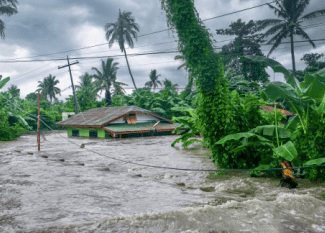41% of U.S. Rental Housing Is in High-Risk Climate Areas, Study Finds
Millions of homes across the U.S. are already vulnerable to climate change, according to a new study.

The study uses the Federal Emergency Management Agency’s National Risk Index to determine which areas are increasingly likely to experience events such as wildfires, flooding, earthquakes and hurricanes.
“As a growing number of rental units are damaged by environmental hazards, the cost to repair and rebuild homes will increase, as will the insurance costs in high- risk areas,” the report says. “The increasing incidence of costly disasters will almost certainly render an increasing number of rental units uninhabitable, forcing residents to relocate and threatening to further reduce the supply of rental housing.”
California has the most rental units at risk, with 4.6 million units, or about 77% of the state’s rental stock, located in census tracts that are moderately to very likely to experience an extreme weather event. Florida had the second most with 2.4 million units at risk, roughly 89% of the state’s rental stock.
The risk isn’t contained to the continental U.S. coastline or to states like California or Florida where extreme weather events are an annual occurrence. Almost every state now has high-risk counties, defined as those with 20,000 units or more at risk.
The location of the units is one part of the puzzle. Almost half of rentals built since 2000 and 45% of single-family rentals are in high-risk areas.
But another risk factor is physical inadequacy. While just 24% of rentals built before 1940 are in high-risk areas, they may be less likely to emerge intact following an extreme weather event. For the same reason, manufactured housing units may also be at higher risk than they would seem based on their geography.
Low-cost rental housing and federally subsidized units are also at risk, the study found. Around 3.2 million units with rents below $600 are in high-risk areas, as are 1.2 million units that benefit from the Low-Income Housing Tax Credit program.
“To protect households and communities, states and localities will need to push for hazard mitigation and climate adaptation measures for individual properties and across regions,” the report says.
Housing developers and tenants have increasingly ventured into areas that are more prone to drought, wildfires and flooding over the past decade, studies from Redfin previously found.
Paying Too Much For Insurance?
Get a FREE quote to insure your rental properties for less.
A lack of land availability in town centers has pushed new housing projects into areas with more flammable vegetation, with 55% of housing built within the last decade at risk of a potential fire, Redfin’s 2022 study found.
Meanwhile, renters have also wandered further afield. Of the 1 million Americans who relocated to other states during the pandemic, many moved to locations with some of the highest risks of extreme heat, wildfires and flooding, according to a 2023 Redfin study.
“The consequences of climate change haven’t fully sunk in for many Americans because oftentimes, homeowners and renters don’t foot the whole bill when disaster strikes,” Redfin Chief Economist Daryl Fairweather said in a statement last year.
Source: Bisnow















 Accessibility
Accessibility